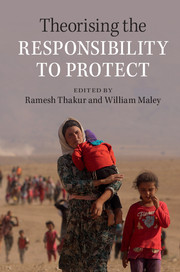Book contents
- Frontmatter
- Contents
- List of figures
- Notes on contributors
- Part I Context
- Part II The Responsibility to Protect, normative theory and global governance
- Part III The Responsibility to Protect and international social purposes
- 12 United Nations peacekeeping and the Responsibility to Protect
- 13 Humanitarian law, refugee protection and the Responsibility to Protect
- 14 Is the Responsibility to Protect doctrine gender-neutral?
- 15 The Responsibility to Protect: a Western idea?
- 16 Colonialism and the Responsibility to Protect
- Index
16 - Colonialism and the Responsibility to Protect
from Part III - The Responsibility to Protect and international social purposes
Published online by Cambridge University Press: 05 August 2015
- Frontmatter
- Contents
- List of figures
- Notes on contributors
- Part I Context
- Part II The Responsibility to Protect, normative theory and global governance
- Part III The Responsibility to Protect and international social purposes
- 12 United Nations peacekeeping and the Responsibility to Protect
- 13 Humanitarian law, refugee protection and the Responsibility to Protect
- 14 Is the Responsibility to Protect doctrine gender-neutral?
- 15 The Responsibility to Protect: a Western idea?
- 16 Colonialism and the Responsibility to Protect
- Index
Summary
Introduction
The Responsibility to Protect (R2P) is a relatively recent entrant in the burgeoning lexicon of contemporary international relations. It was only in 2001 that the International Commission on Intervention and State Sovereignty (ICISS) articulated and developed the idea of R2P. The attempt was made consciously to depart from the doctrine of humanitarian intervention and its prior instantiations which had lent it a fairly dubious international reputation. As a follow-up to the 2001 report assembled by Gareth Evans, Mohamed Sahnoun and their team, the UN Secretary-General Kofi Anan in 2004 inaugurated a High-Level Panel on Threats, Challenges, and Change. This latter effort culminated in the Report titled A More Secure World: Our Shared Responsibility. The R2P was characterised here as an ‘emerging norm’. Subsequently, in 2005 at the UN General Assembly World Summit, the R2P was invoked again in the context of ‘helping States build capacity to protect their populations from genocide, war crimes, ethnic cleansing and crimes against humanity and to assisting those which are under stress before crises and conflicts break out’.
There are several important facets pertaining to the evolution of R2P and where we stand currently in relation to both the doctrine and its applicability. First, it is important not to equate R2P with ‘formal international law’. Second, the phraseology of an ‘emerging norm’ implies that it is ‘a norm situated in limbo halfway between existence and non-existence’. Third, in terms of the broader politics surrounding R2P, notwithstanding claims to impartial applicability, I argue that there is sufficient reason to be wary of the ‘fiction of neutrality’. Fourth, it is apparent that there exist unresolved grey areas both in doctrinal and operational terms as far as R2P is concerned and the attendant ‘ambiguity’ undermines its overall reputation. Finally, I concur with the view that R2P has not been able to circumvent in any fashion the more generic ‘paternalism’ of the powerful that has long characterised the dominant framings of contemporary international relations practice. It has been rather unsuccessful in assuaging deeper and well-founded historical suspicions, especially among decolonised states, about the motivations of major Western powers in the international system. Arguably, then, R2P represents ‘old wine in a new bottle’, cosmetic in its effort to remedy both the legacy and perils of humanitarian intervention.
- Type
- Chapter
- Information
- Theorising the Responsibility to Protect , pp. 305 - 322Publisher: Cambridge University PressPrint publication year: 2015
- 10
- Cited by



